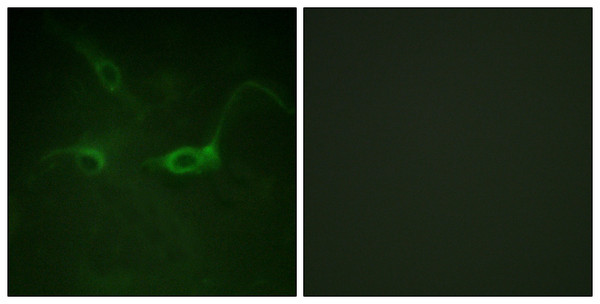| Post Translational Modifications | Autophosphorylated. Binding of FGF family members together with heparan sulfate proteoglycan or heparin promotes receptor dimerization and autophosphorylation on tyrosine residues. Autophosphorylation occurs in trans between the two FGFR molecules present in the dimer and proceeds in a highly ordered manner. Initial autophosphorylation at Tyr-653 increases the kinase activity by a factor of 50 to 100. After this, Tyr-583 becomes phosphorylated, followed by phosphorylation of Tyr-463, Tyr-766, Tyr-583 and Tyr-585. In a third stage, Tyr-654 is autophosphorylated, resulting in a further tenfold increase of kinase activity. Phosphotyrosine residues provide docking sites for interacting proteins and so are crucial for FGFR1 function and its regulation. Ubiquitinated. FGFR1 is rapidly ubiquitinated by NEDD4 after autophosphorylation, leading to internalization and lysosomal degradation. CBL is recruited to activated FGFR1 via FRS2 and GRB2, and mediates ubiquitination and subsequent degradation of FGFR1. N-glycosylated in the endoplasmic reticulum. The N-glycan chains undergo further maturation to an Endo H-resistant form in the Golgi apparatus. |
| Function | Tyrosine-protein kinase that acts as a cell-surface receptor for fibroblast growth factors and plays an essential role in the regulation of embryonic development, cell proliferation, differentiation and migration. Required for normal mesoderm patterning and correct axial organization during embryonic development, normal skeletogenesis and normal development of the gonadotropin-releasing hormone (GnRH) neuronal system. Phosphorylates PLCG1, FRS2, GAB1 and SHB. Ligand binding leads to the activation of several signaling cascades. Activation of PLCG1 leads to the production of the cellular signaling molecules diacylglycerol and inositol 1,4,5-trisphosphate. Phosphorylation of FRS2 triggers recruitment of GRB2, GAB1, PIK3R1 and SOS1, and mediates activation of RAS, MAPK1/ERK2, MAPK3/ERK1 and the MAP kinase signaling pathway, as well as of the AKT1 signaling pathway. Promotes phosphorylation of SHC1, STAT1 and PTPN11/SHP2. In the nucleus, enhances RPS6KA1 and CREB1 activity and contributes to the regulation of transcription. FGFR1 signaling is down-regulated by IL17RD/SEF, and by FGFR1 ubiquitination, internalization and degradation. |
| Protein Name | Fibroblast Growth Factor Receptor 1Fgfr-1Basic Fibroblast Growth Factor Receptor 1BfgfrBfgf-R-1Fms-Like Tyrosine Kinase 2Flt-2N-SamProto-Oncogene C-FgrCd Antigen Cd331 |
| Database Links | Reactome: R-HSA-109704Reactome: R-HSA-1257604Reactome: R-HSA-1839120Reactome: R-HSA-1839122Reactome: R-HSA-190370 P11362-19Reactome: R-HSA-190373 P11362-1Reactome: R-HSA-190374 P11362-1Reactome: R-HSA-2219530Reactome: R-HSA-375165 P11362-1Reactome: R-HSA-445144 P11362-1Reactome: R-HSA-5654219Reactome: R-HSA-5654687Reactome: R-HSA-5654688Reactome: R-HSA-5654689Reactome: R-HSA-5654693Reactome: R-HSA-5654726Reactome: R-HSA-5655302Reactome: R-HSA-5673001Reactome: R-HSA-6811558Reactome: R-HSA-8853336Reactome: R-HSA-9758919Reactome: R-HSA-9793380 |
| Cellular Localisation | Cell MembraneSingle-Pass Type I Membrane ProteinNucleusCytoplasmCytosolCytoplasmic VesicleAfter Ligand BindingBoth Receptor And Ligand Are Rapidly InternalizedCan Translocate To The Nucleus After InternalizationOr By Translocation From The Endoplasmic Reticulum Or Golgi Apparatus To The CytosolAnd From There To The Nucleus |
| Alternative Antibody Names | Anti-Fibroblast Growth Factor Receptor 1 antibodyAnti-Fgfr-1 antibodyAnti-Basic Fibroblast Growth Factor Receptor 1 antibodyAnti-Bfgfr antibodyAnti-Bfgf-R-1 antibodyAnti-Fms-Like Tyrosine Kinase 2 antibodyAnti-Flt-2 antibodyAnti-N-Sam antibodyAnti-Proto-Oncogene C-Fgr antibodyAnti-Cd Antigen Cd331 antibodyAnti-FGFR1 antibodyAnti-BFGFR antibodyAnti-CEK antibodyAnti-FGFBR antibodyAnti-FLG antibodyAnti-FLT2 antibodyAnti-HBGFR antibody |
Information sourced from Uniprot.org











